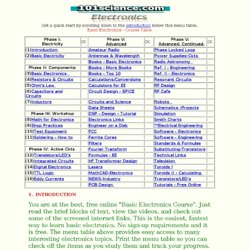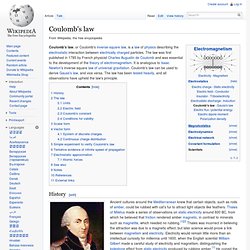

Basic Electronics. {*style:<b> Get a quick start by scrolling down to the introduction below this menu table.

Basic Electronics - Course Table You are at the best, free online "Basic Electronics Course". Just read the brief blocks of text, view the videos, and check out some of the screened internet links. This is the easiest, fastest way to learn basic electronics. {*style:<b><b>Maybe you already know some basic electronics and want to test yourself to see exactly how much you do know. </b></b>*} {*style:<b>Explanation of AC and DC currents. </b>*} {*style:<b><b><b> P - I*V </b></b></b>*} Engineering ToolBox.
Electrotech 2. Electrotechnology 1. 8.02 Video Lectures. Lecture 3: Electric Flux and Gauss's Law. Gauss's law. In physics, Gauss's law, also known as Gauss's flux theorem, is a law relating the distribution of electric charge to the resulting electric field.

The law was formulated by Carl Friedrich Gauss in 1835, but was not published until 1867.[1] It is one of the four Maxwell's equations which form the basis of classical electrodynamics, the other three being Gauss's law for magnetism, Faraday's law of induction, and Ampère's law with Maxwell's correction. Gauss's law can be used to derive Coulomb's law,[2] and vice versa. Vacuum permittivity. The physical constant ε0, commonly called the vacuum permittivity, permittivity of free space or electric constant, is an ideal, (baseline) physical constant, which is the value of the absolute dielectric permittivity of classical vacuum.

Its value is: ε0 = 8.854 187 817... x 10−12 [F/m] (farads per meter). This constant relates the units for electric charge to mechanical quantities such as length and force.[1] For example, the force between two separated electric charges (in the vacuum of classical electromagnetism) is given by Coulomb's law: where q1 and q2 are the charges, and r is the distance between them. Likewise, ε0 appears in Maxwell's equations, which describe the properties of electric and magnetic fields and electromagnetic radiation, and relate them to their sources. Value[edit] The value of ε0 is currently defined by the formula[2] The historical origins of the electric constant ε0, and its value, are explained in more detail below.
Lecture 2: Electric Field and Dipoles. Coulomb's law. Coulomb's law, or Coulomb's inverse-square law, is a law of physics describing the electrostatic interaction between electrically charged particles.

The law was first published in 1785 by French physicist Charles Augustin de Coulomb and was essential to the development of the theory of electromagnetism. It is analogous to Isaac Newton's inverse-square law of universal gravitation. Coulomb's law can be used to derive Gauss's law, and vice versa. The law has been tested heavily, and all observations have upheld the law's principle. History[edit] Charles Augustin de Coulomb.
Lecture 1: What holds our world together? ELECTRICAL ENGINEERING. Electrical Engineering. ELECTRICITY. Scope and content of Wiki EIG - Electrical Installation Guide. The wiki EIG (Electrical Installation Guide) has been written for electrical Engineers who have to design, realize, inspect or maintain electrical installations in compliance with international Standards of the International Electrotechnical Commission (IEC).

"Which technical solution will guarantee that all relevant safety rules are met? " This question has been a permanent guideline for the elaboration of this wiki EIG guide. An international Standard such as the IEC 60364 "Electrical Installation in Buildings" specifies extensively the rules to comply with to ensure safety and predicted operational characteristics for all types of electrical installations. As the Standard must be extensive, and has to be applicable to all types of products and the technical solutions in use worldwide, the text of the IEC rules is complex, and not presented in a ready-to-use order. The Standard cannot therefore be considered as a working handbook, but only as a reference document.